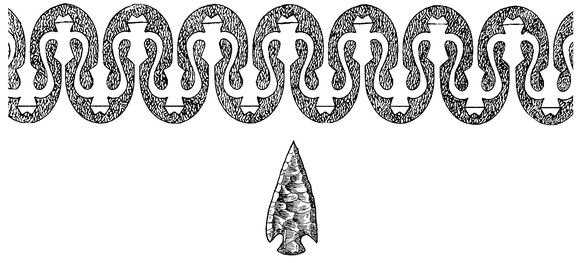
Ask any American to name the oldest city in the United States and he might tell you St. Augustine, Florida (A.D. 1565). Among an enlightened few, the name Old Oraibi (A.D. 1240), in the Hopi Mesas, might pop up. But, with apologies to both of these places, we wish to point out that North America’s oldest city was not located in Florida—or even in the Southwest—nor was it built around St. Louis, or in the fertile valleys of Ohio. Rather, to find it, you must journey to northeastern Louisiana, just outside of the small town of Epps. There, under the superb management of the state of Louisiana, you can still walk the stunning earthworks of Poverty Point, North America’s first true city.
While earthen mound construction begins over six thousand years ago in North America, Poverty Point was inhabited between 3,750 and 3,350 years before present. From radiocarbon dates, most of Poverty Point’s incredible earthworks were created during the last century of occupation. At its height, a permanent population of several thousand people lived on Poverty Point’s curving ridges. They traded for goods as far north as Wisconsin and Ohio. Materials were imported to Poverty Point across nearly fifteen hundred miles of Archaic wilderness.
The site itself is huge. From Lower Jackson Mound on the south to Motley Mound on the north is a little over five miles. The main earthworks cover more than four hundred acres and may contain as much as one million cubic yards of earth that was dug out of the
ground and packed on human backs to build this leviathan. In sheer size it would remain unmatched for another fifteen hundred years.
We agree with Jon Gibson that Poverty Point is a grand-scale projection of the human mind onto the landscape. Its form was not accidental or random, but a reflection of a shared vision of their physical as well as spiritual world, their kinship systems, and creation mythology.
A note on kinship: Non-Western societies organize their social structure in many different ways. What we see reflected in Poverty Point’s architecture suggests two moieties, or social divisions, that contain three clans each. We have utilized a matrilineal matrilocal kinship system since that was present throughout the south.
Our reconstruction of prehistoric cosmology in People of the Owl must remain tentative; but we have looked for constants in South and Central Eastern Woodland mythology and oral tradition. We discarded elements that reflect later Mississippian (People of the River) agricultural traits. What is left is a shared tripartite belief in the surface of the earth, the sky above, and the underworld.
We have used real places as a setting for the story. Poverty Point is Sun Town. The Panther’s Bones is set at the Caney Mounds (16CT5) in Catahoula County. When Saw Back is exiled, it is to the Jaketown site in Mississippi. Twin Circles references the Clairborne Site near the mouth of the Pearl River in southern Mississippi. While we did not extensively explore distant Poverty Point settlements in People of the Owl, sites containing Poverty Point’s distinctive artifacts have been found as far away as the Florida Gulf Coast.
So, what explains this spectacular thirty-five-hundred-year-old cultural florescence? These people were hunter-gatherers. Intensive corn agriculture wouldn’t catch on for another two thousand years. The answer seems to lie in the richness of the Lower Mississippi Valley and its yearly floods. The people at Poverty Point ate everything that walked, crawled, swam, burrowed, and grew in their benevolent food-rich environment. In short, the Lower Mississippi Valley provided the surplus in resources that allowed remarkable cultural achievements.
In coming years, we hope to learn a great deal more. As of this writing, one-half of one percent of the site has been excavated. In our own research with Linda Scott Cummings on Poverty Point Objects—PPOs—or cooking clays, we have recovered the first starches, phytoliths, and pollen residue from the food they cooked in their earth ovens thirty-five hundred years ago. As more research is tackled, our view of this complex site is going to change
substantially. It will be important research. We believe that Poverty Point was to North America what the Fertile Crescent was to Europe: the place that generated and disseminated cultural concepts that would influence subsequent cultures across the eastern woodlands.
Information on the site is as close as your computer: povertypoint@crt.la.us. Jon Gibson’s excellent read, The Ancient Mounds of Poverty Point, is available from University Press of Florida. For an overview of the whole of North American archaeology, we recommend Brian Fagan’s Ancient North America published by Thames and Hudson. At the end of People of the Owl you will find a selected bibliography. Finally, we urge you to visit the Poverty Point State Commemorative Area in person. Until you experience the wonder of it yourself, you will never fully understand the magic.